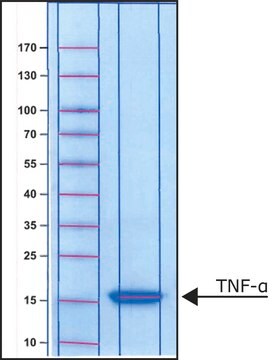SRP6552
TGF-β3 from mouse
recombinant, expressed in E. coli, ≥98% (SDS-PAGE)
Synonyme(s) :
Transforming growth factor beta-3
About This Item
Produits recommandés
Source biologique
mouse
Produit recombinant
expressed in E. coli
Essai
≥98% (SDS-PAGE)
Forme
liquid
Poids mol.
25.5 kDa
Conditionnement
pkg of 5 μg
pkg of 50 μg
pkg of 500 μg
Concentration
0.25 mg/mL
Impuretés
≤1 EU/μg endotoxin (LAL test)
Numéro d'accès UniProt
Conditions d'expédition
dry ice
Température de stockage
−70°C
Informations sur le gène
mouse ... TGF-beta-1(21803)
Catégories apparentées
Description générale
Recombinant mouse TGF-β3 is a non-glycosylated, disulfide-linked homodimer, containing two 112 amino acid chains, with a total molecular weight of 25.5kDa.
Actions biochimiques/physiologiques
Forme physique
Code de la classe de stockage
3 - Flammable liquids
Classe de danger pour l'eau (WGK)
WGK 1
Point d'éclair (°F)
does not flash
Point d'éclair (°C)
does not flash
Faites votre choix parmi les versions les plus récentes :
Certificats d'analyse (COA)
It looks like we've run into a problem, but you can still download Certificates of Analysis from our Documents section.
Si vous avez besoin d'assistance, veuillez contacter Service Clients
Déjà en possession de ce produit ?
Retrouvez la documentation relative aux produits que vous avez récemment achetés dans la Bibliothèque de documents.
Notre équipe de scientifiques dispose d'une expérience dans tous les secteurs de la recherche, notamment en sciences de la vie, science des matériaux, synthèse chimique, chromatographie, analyse et dans de nombreux autres domaines..
Contacter notre Service technique



